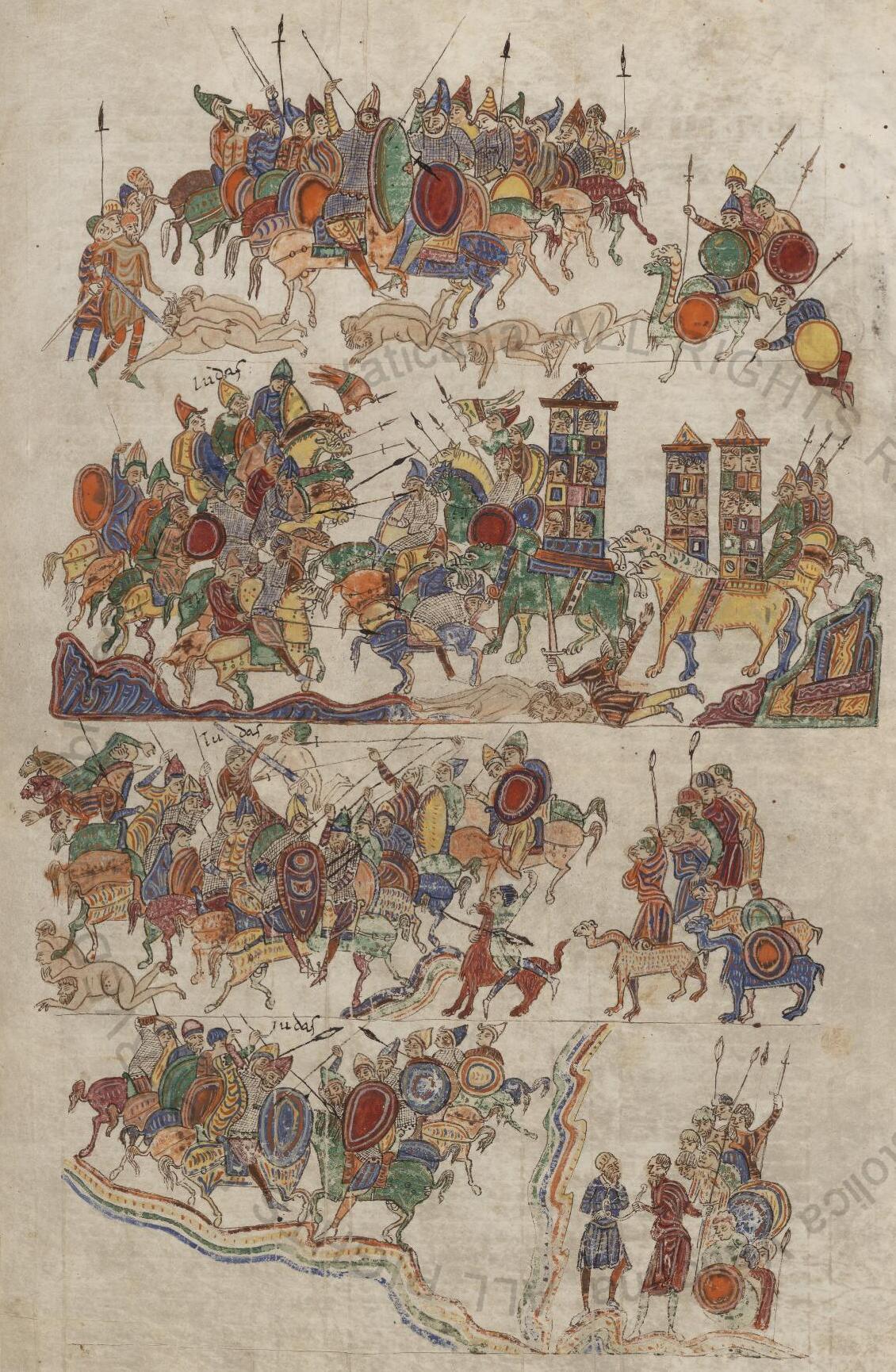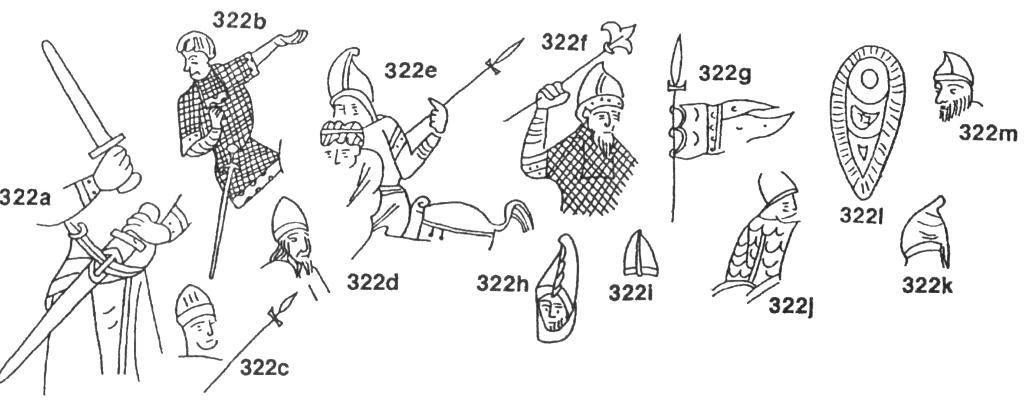
Amazon Audible Gift Memberships
Illustration from the Ripoll Bible (Farfa Bible).
Folio 342r: 1 Maccabees
 |
1st Register The Battle of Bethhoron 10 Apollonius now gathered together Gentiles and a large force from Samaria to fight against Israel. 11 When Judas learned of it, he went out to meet him, and he defeated and killed him. Many were wounded and fell, and the rest fled. 12 Then they seized their spoils; and Judas took the sword of Apollonius, and used it in battle the rest of his life. 13 When Seron, the commander of the Syrian army, heard that Judas had gathered a large company, including a body of faithful soldiers who stayed with him and went out to battle,14 he said, “I will make a name for myself and win honour in the kingdom. I will make war on Judas and his companions, who scorn the king’s command." 15 Once again a strong army of godless men went up with him to help him, to take vengeance on the Israelites. 16 When he approached the ascent of Beth-horon, Judas went out to meet him with a small company. 17 But when they saw the army coming to meet them, they said to Judas, “How can we, few as we are, fight against so great and so strong a multitude? And we are faint, for we have eaten nothing today." 18 Judas replied, “It is easy for many to be hemmed in by few, for in the sight of Heaven there is no difference between saving by many or by few. 19 It is not on the size of the army that victory in battle depends, but strength comes from Heaven. 20 They come against us in great insolence and lawlessness to destroy us and our wives and our children, and to despoil us;21 but we fight for our lives and our laws. 22 He himself will crush them before us; as for you, do not be afraid of them." 23 When he finished speaking, he rushed suddenly against Seron and his army, and they were crushed before him. 24 They pursued them down the descent of Beth-horon to the plain; eight hundred of them fell, and the rest fled into the land of the Philistines. 25 Then Judas and his brothers began to be feared, and terror fell on the Gentiles all around them. 26 His fame reached the king, and the Gentiles talked of the battles of Judas. (1 Maccabees 3:10-26) |
|
2nd Register The Battle at Beth-zechariah 32 Then Judas marched away from the citadel and encamped at Beth-zechariah, opposite the camp of the king. 33 Early in the morning the king set out and took his army by a forced march along the road to Beth-zechariah, and his troops made ready for battle and sounded their trumpets. 34 They offered the elephants the juice of grapes and mulberries, to arouse them for battle. 35 They distributed the animals among the phalanxes; with each elephant they stationed a thousand men armed with coats of mail, and with brass helmets on their heads; and five hundred picked horsemen were assigned to each beast. 36 These took their position beforehand wherever the animal was; wherever it went, they went with it, and they never left it. 37 On the elephants were wooden towers, strong and covered; they were fastened on each animal by special harness, and on each were four armed men who fought from there, and also its Indian driver. 38 The rest of the cavalry were stationed on either side, on the two flanks of the army, to harass the enemy while being themselves protected by the phalanxes. 39 When the sun shone on the shields of gold and brass, the hills were ablaze with them and gleamed like flaming torches. 40 Now a part of the king’s army was spread out on the high hills, and some troops were on the plain, and they advanced steadily and in good order. 41 All who heard the noise made by their multitude, by the marching of the multitude and the clanking of their arms, trembled, for the army was very large and strong. 42 But Judas and his army advanced to the battle, and six hundred of the king’s army fell. 43 Now Eleazar, called Avaran, saw that one of the animals was equipped with royal armour. It was taller than all the others, and he supposed that the king was on it. 44 So he gave his life to save his people and to win for himself an everlasting name. 45 He courageously ran into the midst of the phalanx to reach it; he killed men right and left, and they parted before him on both sides. 46 He got under the elephant, stabbed it from beneath, and killed it; but it fell to the ground upon him and he died. 47 When the Jews saw the royal might and the fierce attack of the forces, they turned away in flight. (1 Maccabees 6 32-47)) | |
|
3rd Register Perhaps Nicanor fights Judas at the battle of Capharsalama (1 Maccabees 7:31-32) or Nicanor fights Judas at the battle between Beth-Horon and Adasa (1 Maccabees 7:39-46) | |
|
4th Register (left) The Last Battle of Judas (?) 11 Then the army of Bacchides marched out from the camp and took its stand for the encounter. The cavalry was divided into two companies, and the slingers and the archers went ahead of the army, as did all the chief warriors. 12 Bacchides was on the right wing. Flanked by the two companies, the phalanx advanced to the sound of the trumpets; and the men with Judas also blew their trumpets. 13 The earth was shaken by the noise of the armies, and the battle raged from morning until evening. 14 Judas saw that Bacchides and the strength of his army were on the right; then all the stout-hearted men went with him, 15 and they crushed the right wing, and he pursued them as far as Mount Azotus. 16 When those on the left wing saw that the right wing was crushed, they turned and followed close behind Judas and his men. 17 The battle became desperate, and many on both sides were wounded and fell. 18 Judas also fell, and the rest fled. 19 Then Jonathan and Simon took their brother Judas and buried him in the tomb of their ancestors at Modein, 20 and wept for him. All Israel made great lamentation for him; they mourned for many days and said, 21 ‘How is the mighty fallen, the saviour of Israel!’ (1 Maccabees 9:1-21) 4th Register (right) Perhaps Tryphon Captures Jonathan (1 Maccabees 12:48) |
